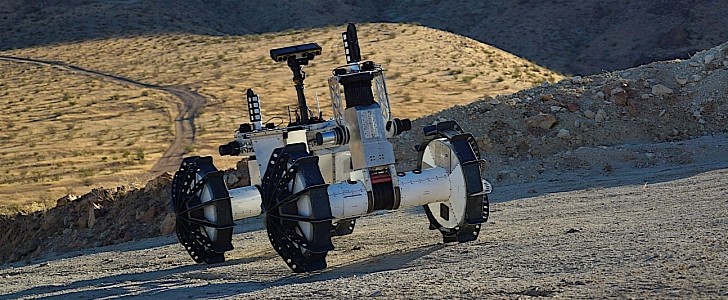In the early months of next year, NASA's Perseverance rover will arrive on Mars for the most important mission ever attempted on the Red Planet. The machine, the most advanced of its kind ever made, is packed with technology, including experiments that will be conducted for the first time. But work on other rovers is already underway over at NASA and its Jet Propulsion Laboratory (JPL).
One of the vehicles space engineers are currently developing is called DuAxel. That’s not-so-short for dual-axel, because essentially this is not one rover, but two. A design chosen because, well, two different machines are of course better than one.
In its fully-combined shape, DuAxel looks not unlike what you’d expect for a machine designed with space exploration in mind. It has four wheels (metal ones), and a platform in between them, supporting a host of instruments.
But this configuration is not necessarily suitable for crater walls, pits, scarps, vents, and other extreme terrain one usually finds on the Moon, Mars, or wherever. That’s why the thing can cut itself in half for better navigating such traps.
More precisely, once the rover stops, it can lower its chassis and begin separating front from rear. One side gets anchored into the ground, while the other starts descending into say the pit ahead, while remaining tethered to its better half.
This allows for the rover to act as a platform when fully bodied, but also opens opportunities for the exploration of otherwise unreachable areas.
"The key advantage of using DuAxel is made clear when you have landing site uncertainty, such as we do on Mars, or you want to move to a new location to rappel and explore with Axel," said in a statement Patrick Mcgarey, a robotic technologist at JPL and DuAxel team member.
"It enables untethered driving from the landing site and allows for temporary anchoring to the terrain because it is essentially a transforming robot made for planetary exploration."
NASA says the idea of a modular rover is not new, and first surfaced back in the 1990s. It only recently got to test it in the Mojave Desert, but is yet to determine a real-life use for it. Until it decides, engineers will continue to better DuAxel, and even plan on turning it into a machine with three such modules.
In its fully-combined shape, DuAxel looks not unlike what you’d expect for a machine designed with space exploration in mind. It has four wheels (metal ones), and a platform in between them, supporting a host of instruments.
But this configuration is not necessarily suitable for crater walls, pits, scarps, vents, and other extreme terrain one usually finds on the Moon, Mars, or wherever. That’s why the thing can cut itself in half for better navigating such traps.
More precisely, once the rover stops, it can lower its chassis and begin separating front from rear. One side gets anchored into the ground, while the other starts descending into say the pit ahead, while remaining tethered to its better half.
This allows for the rover to act as a platform when fully bodied, but also opens opportunities for the exploration of otherwise unreachable areas.
"The key advantage of using DuAxel is made clear when you have landing site uncertainty, such as we do on Mars, or you want to move to a new location to rappel and explore with Axel," said in a statement Patrick Mcgarey, a robotic technologist at JPL and DuAxel team member.
"It enables untethered driving from the landing site and allows for temporary anchoring to the terrain because it is essentially a transforming robot made for planetary exploration."
NASA says the idea of a modular rover is not new, and first surfaced back in the 1990s. It only recently got to test it in the Mojave Desert, but is yet to determine a real-life use for it. Until it decides, engineers will continue to better DuAxel, and even plan on turning it into a machine with three such modules.








